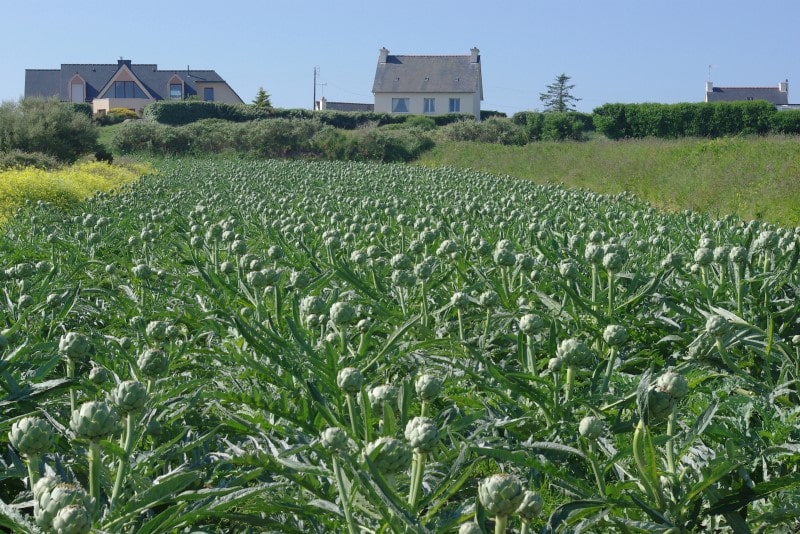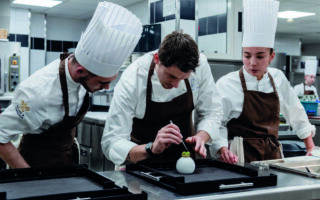
Eat seasonally: What’s in season in France in June
Each month, the French Department for Agriculture releases its list of what’s in season across France – and right now, the market stalls are bursting with leafy vegetables, fresh peas and beans and juicy summer fruits, as well as meats and fish to enjoy grilled or in salads. Let’s shop!
VEGETABLES
The artichoke belongs to the thistle family and it’s the flowers we so enjoy eating, either on their own dipped in a homemade lemon vinaigrette, or in salads. Michelin-starred chef Julia Sedefdjian serves them with anchovies, black olives and lemon juice. Delicious! Look out in particular for the Roussillon IGP artichokes, which benefit from the sea air and La Tramontane wind which blows through the eastern Pyrenees.
Beans (fèves) are rich in protein – watch out for the tender, young variety (févettes) harvested early in the season. Boil for a couple of minutes only, flash-grill on a griddle or chop them up raw and add them to a salad.
Originating from Iran, spinach was introduced to France by the Crusaders in about 1000AD and first appears in French cookbook Le viandier de Taillevent in the Middle Ages. Pop it in an omelette, shred it in a salad, sauté it as a side dish… you can pretty much find a role for it in every meal, from breakfast to supper!

FRUIT
Cherries are mainly produced in Auvergne-Rhône-Alpes, Provence-Alpes-Côte-d’Azur and Occitanie. A large number of varieties are available, such as Reverchon, Van, Stark, Rainier and Duroni. Label Rouge cherries are harvested by hand as they mature, six weeks after the trees have blossomed.
The melon is related to the cucumber, courgette and squash. The Haut-Poitou IGP melon, grown between Saumur and Poitier, draws its water from the clay-limestone soil rich in tufa stone. Melons from Quercy IGP (Lot and Tarn-et-Garonne) and Lectoure IGP (Gers) are harvested by hand when they are perfectly ripe. Fancy something a little different? Serve it as a gazpacho with slices of yellow pepper.
FISH
Octopus is caught in the Mediterranean Sea, the Bay of Biscay and the English Channel. A tip to tenderise its flesh is to freeze it for six hours before simmering it and making an authentic tielle sétoise, an octopus and tomato pie which is the speciality of Sète in Languedoc. Some 1,130 tonnes of octopus were sold in French tidal halls in 2020.
The crab lives on the rocky and stony bottoms of the Atlantic Ocean or the Mediterranean Sea. Tip: it is better to buy it alive for its freshness and cook it in court bouillon with a bouquet garni for 15 to 20 minutes. Enjoy it warm with a good homemade mayonnaise.
MEAT
Veal is light and tender thanks to the method of feeding calves mainly on milk with a little grain and grass. Different types of production and official marks of quality offer a wide choice. ‘Veau de boucherie’ (butcher’s veal) comes from a dairy farm and is five to six months old), while ‘veau élevé sous la mère‘ are calves fed by their mothers until they reach weaning. Look out for Vedelou d’Auvergne and Bretanin de Bretagne Label Rouge veal, as well as calves with a Protected Geographical Indication, such as veau d’Aveyron and veau du Ségala IGP, rosée des Pyrénées catalanes IGP and veau fermier du Limousin IGP.
Cuts like the collar or the shank with its marrow bone are delicious in slow-cooked recipes like osso bucco. Or how about veal tongue? Confit slowly and serve cold cut into strips with a caper vinaigrette.
When shopping, look for the ‘Viande de veau français’ logo, which ensures that the animals are born, raised, slaughtered and processed in France and that the farming method is respectful of the environment and wellbeing of the animal.
Share to: Facebook Twitter LinkedIn Email
More in Fruit, Produce, Season, seasonal, Vegetables




REPLY